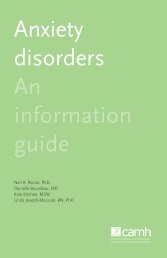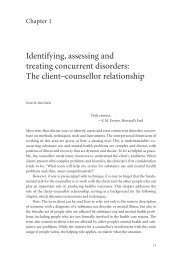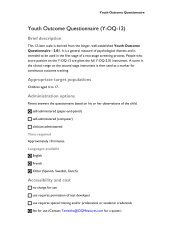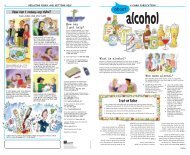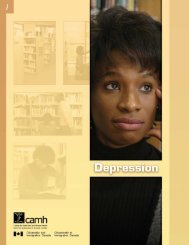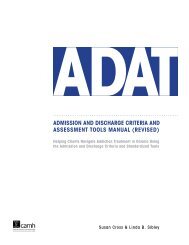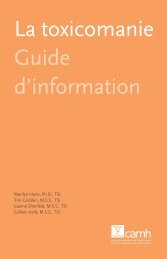A family guide to concurrent disorders - CAMH Knowledge Exchange
A family guide to concurrent disorders - CAMH Knowledge Exchange
A family guide to concurrent disorders - CAMH Knowledge Exchange
- No tags were found...
You also want an ePaper? Increase the reach of your titles
YUMPU automatically turns print PDFs into web optimized ePapers that Google loves.
Introduction <strong>to</strong> Concurrent DisordersWe were just like any other <strong>family</strong> with teenagers, except that while ourdaughter was a real extrovert—she had so many friends, did well in school,never caused us any problems—you know, the kind of kid who can do nowrong . . . our son was so different, the complete opposite. He had friendsgrowing up, but then it seemed like, out of the blue, he didn’t want <strong>to</strong> bearound anyone, including his own <strong>family</strong>. He just got so isolated, youknow? He was always a quiet kid, but this was different. When my husbandcaught him smoking marijuana, and then found bottles of alcohol in hiscloset, it suddenly all started making sense . . . booze and drugs were causinghim <strong>to</strong> crawl in<strong>to</strong> his own little world and withdraw from other people.To tell you the truth, we were actually relieved <strong>to</strong> find out about his drugproblem—we had a plan, you know? We could do something concrete <strong>to</strong>help him, like put him in rehab for teens. The real nightmare started whenhe wouldn’t even go out of the house <strong>to</strong> see our <strong>family</strong> doc<strong>to</strong>r. Even whenwe made sure he wasn’t smoking pot or drinking, he still got worse! It wasanother two years before we found out that he had a mental illness as wellas a drug problem. We had never heard of <strong>concurrent</strong> <strong>disorders</strong> before then.The term <strong>concurrent</strong> <strong>disorders</strong> describes a situation where someone has both a substanceuse problem and a mental health problem at some point in their lifetime. Itcould be in the past. (Has your <strong>family</strong> member ever had a mental health problem?Has your <strong>family</strong> member ever had a substance use problem?) Or it could be a currentproblem. (Does your <strong>family</strong> member currently have both a mental health problemand a substance use problem?)Many families share similar experiences <strong>to</strong> those of the <strong>family</strong> whose s<strong>to</strong>ry is introducedthis chapter. Substance use and mental health problems can lead <strong>to</strong> symp<strong>to</strong>ms andbehaviours that look very similar, so <strong>family</strong> members and treatment professionals oftenfind it difficult <strong>to</strong> determine whether the behaviour they are looking at is due <strong>to</strong> a substanceuse problem or a mental health problem—or both. This chapter is an introduction<strong>to</strong> <strong>concurrent</strong> <strong>disorders</strong>:• how substance use and mental health problems interact• the impact of <strong>concurrent</strong> <strong>disorders</strong> on the <strong>family</strong>• how <strong>concurrent</strong> <strong>disorders</strong> are detected and treated.HOW COMMON ARECONCURRENT DISORDERS?Having either a substance use or a mental health problem significantly increases thelikelihood of having the other. The results of the Epidemiologic Catchment Area Study(Regier et al., 1990) indicate that a person who has a mental health disorder is almostthree times more likely <strong>to</strong> have a substance use disorder at some time in his or her lifethan is a person who does not have a mental health disorder. A person who has a substance4



